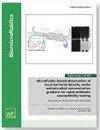主要器官结构和癌症组织的血管化微流体模型
IF 2.6
4区 工程技术
Q2 BIOCHEMICAL RESEARCH METHODS
引用次数: 0
摘要
片上器官设备是一种功能强大的建模系统,研究人员可利用它再现体内器官结构以及这些组织所处的生理条件。这些设备不仅是模拟健康器官行为的有用工具,也是模拟疾病病理或特定药物作用的有用工具。由于生理流体在体内的重要作用,在这些设备中加入流体流动具有重要意义。该领域的最新发展促成了血管化器官芯片设备的诞生,这种设备通过重现相关器官的血管,可以更准确地再现体内观察到的情况。本综述论文将简要概述片上器官设备的历史,然后讨论在生产血管化片上器官方面的发展,以及这些发展对该领域未来的影响。本文章由计算机程序翻译,如有差异,请以英文原文为准。
Vascularized microfluidic models of major organ structures and cancerous tissues
Organ-on-a-chip devices are powerful modeling systems that allow researchers to recapitulate the in vivo structures of organs as well as the physiological conditions those tissues are subject to. These devices are useful tools in modeling not only the behavior of a healthy organ but also in modeling disease pathology or the effects of specific drugs. The incorporation of fluidic flow is of great significance in these devices due to the important roles of physiological fluid flows in vivo. Recent developments in the field have led to the production of vascularized organ-on-a-chip devices, which can more accurately reproduce the conditions observed in vivo by recapitulating the vasculature of the organ concerned. This review paper will provide a brief overview of the history of organ-on-a-chip devices, before discussing developments in the production of vascularized organs-on-chips, and the implications these developments hold for the future of the field.
求助全文
通过发布文献求助,成功后即可免费获取论文全文。
去求助
来源期刊

Biomicrofluidics
生物-纳米科技
CiteScore
5.80
自引率
3.10%
发文量
68
审稿时长
1.3 months
期刊介绍:
Biomicrofluidics (BMF) is an online-only journal published by AIP Publishing to rapidly disseminate research in fundamental physicochemical mechanisms associated with microfluidic and nanofluidic phenomena. BMF also publishes research in unique microfluidic and nanofluidic techniques for diagnostic, medical, biological, pharmaceutical, environmental, and chemical applications.
BMF offers quick publication, multimedia capability, and worldwide circulation among academic, national, and industrial laboratories. With a primary focus on high-quality original research articles, BMF also organizes special sections that help explain and define specific challenges unique to the interdisciplinary field of biomicrofluidics.
Microfluidic and nanofluidic actuation (electrokinetics, acoustofluidics, optofluidics, capillary)
Liquid Biopsy (microRNA profiling, circulating tumor cell isolation, exosome isolation, circulating tumor DNA quantification)
Cell sorting, manipulation, and transfection (di/electrophoresis, magnetic beads, optical traps, electroporation)
Molecular Separation and Concentration (isotachophoresis, concentration polarization, di/electrophoresis, magnetic beads, nanoparticles)
Cell culture and analysis(single cell assays, stimuli response, stem cell transfection)
Genomic and proteomic analysis (rapid gene sequencing, DNA/protein/carbohydrate arrays)
Biosensors (immuno-assay, nucleic acid fluorescent assay, colorimetric assay, enzyme amplification, plasmonic and Raman nano-reporter, molecular beacon, FRET, aptamer, nanopore, optical fibers)
Biophysical transport and characterization (DNA, single protein, ion channel and membrane dynamics, cell motility and communication mechanisms, electrophysiology, patch clamping). Etc...
 求助内容:
求助内容: 应助结果提醒方式:
应助结果提醒方式:


